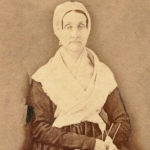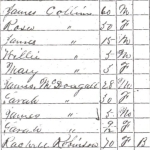From the Series "Black Women In Vermont History"
 (HOST) This week, VPR is featuring a series of stories about Black Women in Vermont History. Today, we hear from Jane Williamson of Rokeby Museum, with the story of Two Rachel Robinsons – one white and one black – in pre-Civil War Vermont.
(HOST) This week, VPR is featuring a series of stories about Black Women in Vermont History. Today, we hear from Jane Williamson of Rokeby Museum, with the story of Two Rachel Robinsons – one white and one black – in pre-Civil War Vermont.
(WILLIAMSON) An odd coincidence has set me to thinking about two Vermont women – both named Rachel Robinson – who lived near each other for three decades before the Civil War. But one Rachel was white and the other was black, so their lives were far from identical.
White Rachel was born into a prosperous Quaker household in 1799 and raised in New York City. She married Rowland T. Robinson in 1820 and lived on his family’s Merino sheep farm in Ferrisburgh, where these two radical abolitionists sheltered runaway slaves. This  Rachel is well known to us through hundreds of items – letters, diaries, writings, and photographs along with many evocative personal belongings – all now in the collection of Rokeby Museum.
Rachel is well known to us through hundreds of items – letters, diaries, writings, and photographs along with many evocative personal belongings – all now in the collection of Rokeby Museum.
Black Rachel is another story. I’ve had to dig for the details of her life in public records. According to the federal census, she was born in Maryland – or Vermont – or even Africa! Based on her age as listed in the census, she was born around 1780. So unless her mother was free, it’s most likely that she was born enslaved.
Black Rachel was middle-aged when she moved to Vergennes in the 1830s and went to work as a domestic servant for prominent lawyer Frederick Woodbridge and his wife Mary. Rachel paid $50 for a house on East Street in 1834 and lived there until her death thirty years later.  Her house must have been small and, probably, old; in thirty years of town tax lists, the house was never valued at even $100 and, often, not even half that. Still, her work for the Woodbridges apparently paid enough to make her independent.
Her house must have been small and, probably, old; in thirty years of town tax lists, the house was never valued at even $100 and, often, not even half that. Still, her work for the Woodbridges apparently paid enough to make her independent.
She was baptized in the Vergennes Congregational Church in 1839, joining ten other African Americans – and the Woodbridges – as members. During the week Fred and Mary Woodbridge were her employers, but on Sunday, they were her fellow church members.
This Rachel dictated a will in 1863 and signed it with a mark. It provides wonderful insight into the material life she made for herself, her values and attachments. Americans were acquiring a taste for refinement during this time, and a "genteel" lifestyle became the goal of even the working classes. Rachel’s home may have been small, but it was furnished with a large picture and a looking glass – signs that she, too, understood and valued gentility.
Rachel’s deepest attachment was evidently to her white employer, Mary Woodbridge. She left her most valuable possessions – her house and the large picture – to Mrs. Woodbridge. But she left the looking glass and other items to two black women who also worked as servants for wealthy families in Vergennes.
Despite their differences, the two Rachels must have known each other. Certainly each was aware that a woman with the same name lived nearby. I like to think that this small coincidence helped bridge the gap of race and class – that it gave them a reason to stop and chat, maybe sharing a laugh over their shared name.
Click here to for a larger view of the 1860 Census Form pictured above.